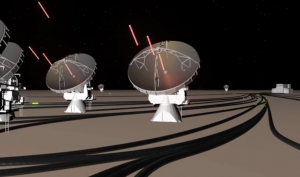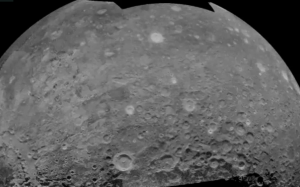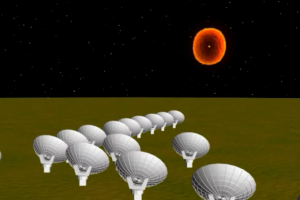In this animation, the radio waves received from objects in space reflect off of ALMA antenna dishes and come to a focus at the subreflector. They bounce down into the center of the dish where the Front End of receiver cartridges sits. Turned into an electronic signal that has been mixed down to a lower frequency that computers can handle, the data travel along fiber optics to the supercomputer known as a correlator. The correlator’s job is to pair up every telescope with every other telesscope and combine their waves. Then those are merged into a single data package from their observation.


Moon Movie in Radar
This movie was created from radar images collected using a transmitter at the Arecibo Observatory (AO) in Puerto Rico and receivers at the Green Bank Telescope (GBT). Radar maps can look like photos, but they represent the amount of energy reflected back toward the transmitter by features on the Moon’s surface. The radar penetrates 10 meters or more into the very dry lunar surface, revealing variations in the abundance of rocks larger than about 10 cm across and seeing differences in the chemistry of rocks that form the Moon’s crust. The movie begins with a view of the north pole of the Moon – the center of the side we can see from Earth is at top. The rotation carries us around the visible edge of the Moon, past the south pole, the giant Orientale basin, and back to the north pole.

Sco X-1, the Movie
This timelapse movie shows 56 hours of changing radio emission from the violent binary system known as Scorpius X-1. Sco X-1 is a star in orbit around a neutron star, the remnant of a supernova explosion. In June of 1999, Sco X-1 brightened and dimmed, and “lobes” of bright radio emission were pushed outward by jets at about half the speed of light. These lobes are made when the fast moving particles in the jet, created from the accretion disk of material in orbit around the dead star, collide with surrounding material caught in the flow. Notice at the start that one moving set of lobes disappears, but new lobes are ejected from the core a few hours later. The size scale is in billions of miles, because Scorpius X-1 covers a volume much larger than our Solar System.

Magnetar Animation
In this artist’s animation, the December 27, 2004 blast from SGR 1806-20 was the brightest outburst ever seen coming from an object beyond our own Solar System. Even at 50,000 light-years away, its burst of gamma rays and X-rays disturbed the Earth’s ionosphere, causing a sudden disruption in some radio communications. A magnetar is a superdense neutron star with a magnetic field thousands of trillions of times more intense than that of the Earth. Scientists believe that SGR 1806-20’s giant burst of energy was somehow triggered by a “starquake” in the neutron star’s crust that caused a catastrophic disruption in the magnetar’s magnetic field. The magnetic disruption “boiled off” particles from the star’s surface into a rapidly-expanding fireball.





